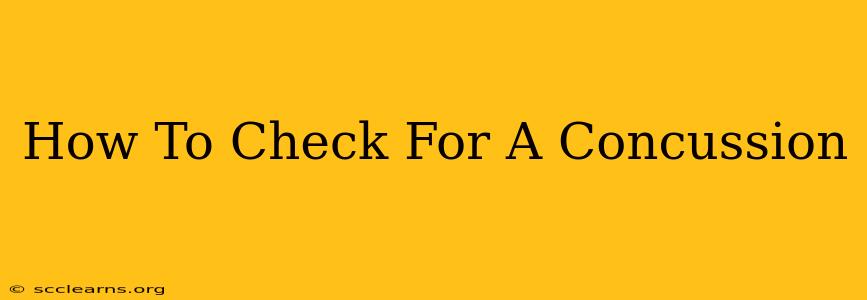A concussion is a type of traumatic brain injury (TBI) caused by a bump, blow, or jolt to the head or body that causes the brain to move rapidly back and forth inside the skull. This can cause the brain to bounce around or twist, resulting in chemical changes in the brain and sometimes stretching and damaging brain cells. Knowing how to check for a concussion is crucial for immediate and effective care. This guide will walk you through the steps to assess someone who may have suffered a concussion.
Recognizing the Signs and Symptoms of a Concussion
Concussions don't always involve loss of consciousness. Many symptoms can be subtle and may not appear immediately after the injury. It's crucial to be aware of both immediate and delayed symptoms.
Immediate Signs and Symptoms:
- Loss of consciousness: While not always present, this is a significant indicator.
- Confusion: Disorientation, difficulty remembering events, or trouble following instructions.
- Dizziness or imbalance: Feeling unsteady on their feet or experiencing vertigo.
- Headache: Often described as severe or throbbing.
- Nausea or vomiting: Feeling sick to their stomach.
- Blurred vision: Difficulty focusing or seeing clearly.
- Sensitivity to light or noise: Experiencing discomfort in brightly lit areas or loud environments.
- Ringing in the ears (tinnitus): A persistent buzzing or ringing sensation.
Delayed Signs and Symptoms:
These symptoms can appear hours, days, or even weeks after the injury:
- Persistent headaches: Headaches that don't go away.
- Sleep disturbances: Difficulty sleeping, sleeping too much, or disrupted sleep cycles.
- Irritability or mood swings: Increased emotional sensitivity or unpredictable behavior changes.
- Difficulty concentrating or remembering things: Problems with focus and memory.
- Fatigue: Persistent exhaustion and low energy.
- Changes in personality or behavior: Acting differently than usual.
How to Assess Someone for a Concussion: The SCAT5 Test
While not a substitute for professional medical evaluation, the SCAT5 (Sport Concussion Assessment Tool 5th edition) provides a structured approach to assessing concussion symptoms. While the full SCAT5 is best administered by trained medical professionals, understanding key aspects can be helpful. Remember, this is not a diagnostic tool; it's a screening tool to help determine the need for professional medical attention.
Key Aspects of Concussion Assessment:
- Ask about the mechanism of injury: How did the injury occur? This information provides context.
- Assess level of consciousness: Were they knocked unconscious? If so, for how long?
- Observe their behavior: Are they confused, disoriented, or exhibiting unusual behavior?
- Perform cognitive testing: Simple memory tests (e.g., remembering a series of numbers) and orientation questions (e.g., what day is it?).
- Balance and coordination tests: Simple tests like standing on one leg or walking heel-to-toe.
When to Seek Immediate Medical Attention
Seek immediate medical attention if:
- The person loses consciousness.
- There's persistent vomiting.
- The person has a seizure.
- There's significant bleeding from the head or ears.
- The person has worsening headaches or other symptoms.
- The person exhibits unusual behavior or changes in mental status.
Important Considerations
- Rest is crucial: Avoid strenuous physical activity and screen time.
- Follow medical advice: Follow your doctor's or other healthcare professional's recommendations closely.
- Gradual return to activity: A step-wise approach to resuming normal activities is essential to avoid re-injury.
This guide provides information for educational purposes only and is not a substitute for professional medical advice. Always consult with a healthcare provider for any concerns about a concussion or other medical condition. Early diagnosis and appropriate management are essential for optimal recovery. Your safety and well-being are paramount.

